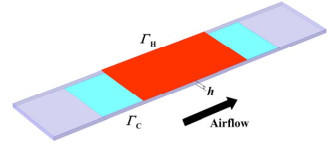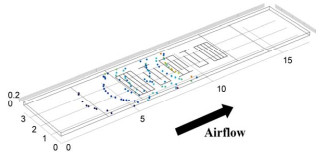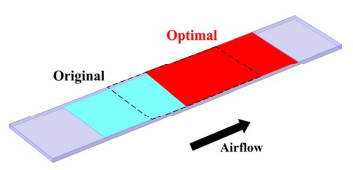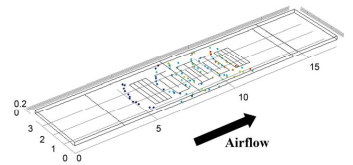PM2.5 refers to particles with a nominal aerodynamic diameter less than or equal to 2.5 μm, which has adverse impact on air environment. To further reduce the manufacturing complexity and to obtain high sensitivity of the existing PM2.5 monitors, a novel PM2.5 monitor based on a surface acoustic wave (SAW) detector and a thermophoretic precipitator was developed.
In 2011, researchers analyzed the airborne nanoparticles distribution in a thermophoretic precipitator, indicating the nonuniform particle deposition distribution on the collection plate. Furthermore, it was proven that the mass sensitivity of a SAW sensor with a resonator configuration varied strongly across the device surface.
Thus, to increase the SAW based PM2.5 monitor’s sensitivity, researchers from the Institute of Acoustics (IOA) of the Chinese Academy of Sciences have recently proposed a method of regarding the particulate deposition distribution on the SAW detector surface.
A heat source and a SAW device in the air current microchannel form the thermophoretic precipitator. When particles move through that temperature gradient, they will experience a force in the direction of decreasing temperature. The force is called thermophoretic force.
To describe the movement of the particles to the surface of SAW detector, a 3-dimensional finite element method with the commercial software COMSOL MULTIPHYSICS is used to model the structure (Fig. 1(a)). By using the Non-Isothermal Flow and the Particle Tracing for Fluid Flow packages with the flow rate of 6 mL/min, the deposition distribution of particles with diameter of 2.5 μm is obtained (Fig. 1(b)).
Research results show that particles are high-density distributed at the entrance and along the centerline of the collection plate. And the distribution exhibits parabolic. Besides, it has been proven before that the optimal sensitive area lies towards the center of the SAW detector with a resonator configuration.
To optimize the original structure, the position of the heat source is moved to right. It aims to guarantee that the particles high-density distributed area corresponds with the optimal sensitive area of the SAW sensor, namely the center of the cold plate (Fig. 2(a)). The corresponding deposition distribution of particles with diameter of 2.5 μm is obtained (Fig. 2(b)).
Based on the results, by changing the microchannel structure, the particles will be deposited on the optimal sensitive area of the SAW detector. And the performance improvement of the sensor by configuring the optimal structure will be achieved.


(a) (b)
Fig. 1 The thermophoretic precipitator: (a) schematic of the original design; (b) deposition distribution of particles with diameter of 2.5 μm (Image by IOA).


(a) (b)
Fig. 2 The thermophoretic precipitator: (a) schematic of the optimal design; (b) deposition distribution of particles with diameter of 2.5 μm (Image by IOA).
Reference:
HAO Wenchang, NIE Zhong, LIU Jiuling, LIU Minghua and HE Shitang. Advances in a Developed Surface Acoustic Wave based Particulate Matter 2.5 Monitor. Proceedings of the 2016 Symposium on Piezoelectricity, Acoustic Waves and Device Applications (Pages 227-229, January 2017). DOI: 10.1109/SPAWDA.2016.7829993
Contact:
HAO Wenchang
Institute of Acoustics, Chinese Academy of Sciences, 100190 Beijing, China
Email: haowenchang12@mails.ucas.ac.cn


